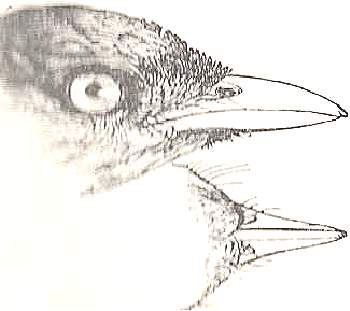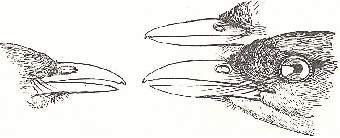|
|
History of the Bulbul and its
Name
The oldest Bulbul fossil records originate from the
Pleistocene epoch, approximately a million years ago. The bird's name appears
to come from the same Arabic word bulbul through the Persian, in
the poetry of which language it plays a great part. The original
word is generally rendered "Nightingale" by translators, this being a correct
interpretation according to Blyth (Calcutta Review,
No. Iv. March
1857, p. 153), who says that it "is a species of true Nightingale."
In this case it is probably the bird named in old texts Daulias hafizi,
in
honour of the great Persian poet (Cf Blandford, Zool. and Geol.
Persia,
p. 169, pl. x. fig. 2; and Dresser, Ibis 1875, p. 338).
But whatever may have been originally intended,
and Yule says (Hobson-Jobson) that the name is derived from the
bird's note, the word Bulbul was applied to various species, all or nearly
all of which belonged to a group which in the 19th Century was called Ixidae
(otherwise
Brachypodidae,
so-called
from their short legs), and usually referred to the ill-defined "Family'"
Timellliidae.
Of
this group Mr. Oates
(Faun. Br. India, Birds, i. pp. 253, 254),
identified sixteen genera, one of them, which was referred to as Molpastes
(which had been formerly included in the genus Pycnonotus, but had been
later separated therefrom), being that which he considered to contain what
may be called the genuine Bulbuls,
In modern times however, the Bulbul has come to
mean all birds within the family Pycnonotidae. There are now around
140 different known species of Bulbul.
|

Diagram of Pycnonotus Genus of Bulbul

Picture of Phyllastrephus Genus of Bulbul
|
Bulbul Description
They are medium sized passerine songbirds who can
reach body sizes similar to the Central European sparrows and up to the
size of blackbirds, around 14 to 28 centimeters. The Bulbul's neck
is very small, and the birds have short wings. Conversely their tail
is rather long, and notched at the end. They have thin legs, with very
soft claws on their feet. The plumage of the Bulbul consists of relatively
long, soft feathers, with. In their neck all Bulbuls have thin hair feathers,
which can become very long in some species. Some species possess
a particularly remarkable feathered crest, for example the Red-whiskered
Bulbul (Pycnonotus jocosus).
Bulbuls are often very remarkably colored and can
exhibit yellow, red and orange body parts depending upon species. Most
species are however inconspicuously olive-brown, yellow or brown to black.
Contrasting colours can be above the belly, the throat, the front area,
the cheeks or parts of the plumage at the beginning of the tail.
There is no gender dimorphism, with the males and female being similarly
colored. Only the young birds are often somewhat darker.
Feeding
They predominantly feed on fruits, and partularly
on berries. However, some species of Bulbul also hunt for insects
or look for worms and other small animals for food, and the Straw-headed
Bulbul (Pycnonotus zeylanicus) seeks out fresh water snails in the
water.
|
Location and habitat of Bulbuls
They occur mainly in the tropical regions of Asia,
Africa and Madagascar. Many species occur endemically in very small
areas, for example the Seychelles Bulbul (Hypsipetes crassirostris),
which lives only in the Seychelles. Most species live in low-lying
areas, only a few choosing to inhabit high altititudes like mountains.
One Bulbul which seems to like high altitudes is the Flavescent
Bulbul, (Pycnonotus flavescens) which can be found at heights of 3,500
meters in mountain forests of Borneo, including Mount Kinabalu National
Park.
Bulbuls and are said to be familiar garden-birds
in countries where they are found. They are very friendly and can
be also tame. The Yellow-vented Bulbul (Pycnonotus goiavier)
is particularly well-known for its preference for cities. Where Bubuls
are found in cities they are usually common, going about in pairs with
a melodious chirping.
Song of the Bulbul
Bulbuls are usually lively birds with a remarkable
and loud song. It usually consists of a lively twitter. Some species
for example the Straw-headed Bulbul (Pycnonotus zeylanicus) have
long and quite complex songs which are comparable to those of the
nightingale. The song of the Red-vented Bulbul (Pycnonotus more
cafer) consists of two changing tones for example . Also the Stripe-throated
Bulbul (Pycnonotus finlaysoni) and the Madagascar Bulbul (Hypsipetes
madagascariensis) have a memorable and a tuneful call.
The Nest and Bulbul Chicks
Bulbuls build open nests from branches and roots,
which are usually positioned in forked branches within the lower ranges
of trees. These are around 20 centimetres in diameter and padded
with leaves or Moss. The females lay and incubate up to five usually pale-pink
to white eggs in their nests. The incubation period is approximately
twelve days, during which time the female is fed by the male Bulbul.
The male bird only rarely takes the female's place in helping to incubate
the eggs. After the chicks have hatched both parents feed the young
birds with insects. Approximately two weeks later the young birds are fledged
and able to fly.
|
|
|





